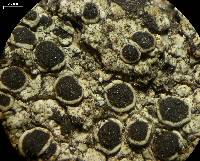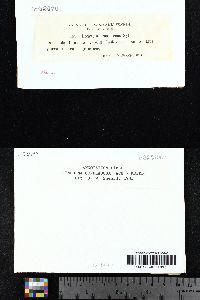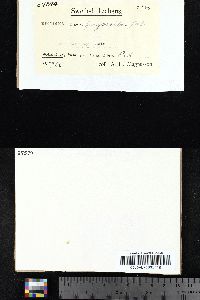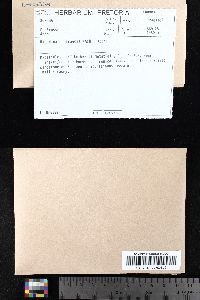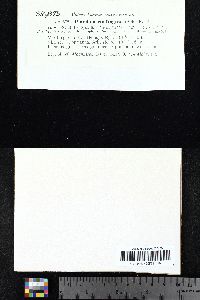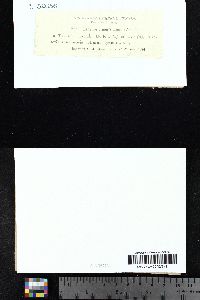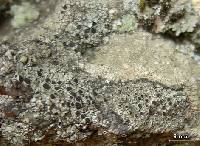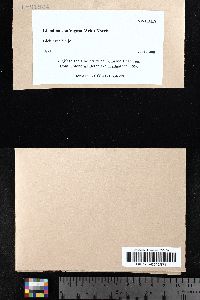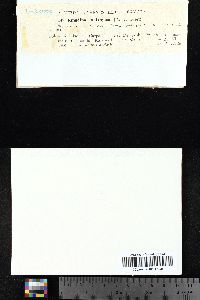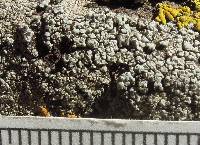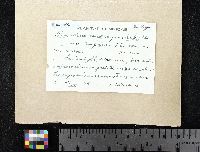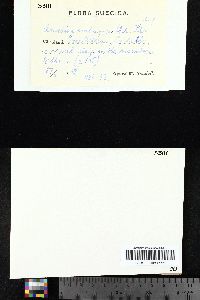
- Home
- Search
- Images
- Species Checklists
- US States: O-Z >
- US National Parks
- Central America
- South America
- US National Parks
- Southern Subpolar Region
|
|
|
|
Family: Physciaceae
[Berengeria confragosa (Ach.) Trevis., moreLecanora confragosa (Ach.) Röhl., Lecanora confragosa var. confragosa (Ach.) Röhl., Lecanora confragosa var. lecidotropa Nyl., Parmelia confragosa Ach., Rinodina exigua var. confragosa (Ach.) Th. Fr., Rinodina metabolica var. confragosa (Ach.) Hazsl., Zeora confragosa (Ach.) Flot.] |
MB#404271 Basionym. Parmelia confragosa Ach., Meth. Lich. 33 (1803). Exsiccatae. Anzi Lich. Lang. Exs. 394 (BM as R. metabolica saxicola); Malme Lich. Suec. Exs. 521, 875 (COLO); Norrlin & Nyl. Herb. Lich. Fen. 159 (COLO as R. crassescens), 275 (COLO); Reliq. Suza. 93 (COLO); Vězda Lich. Sel. Exs. 147 (COLO). Description. Thallus usually thin, light grey, areolate; areoles more or less discrete, to ca. 0.50 mm wide, sometimes with minutely lobate margins, or thick and contiguous; surface plane or rugose, matt; margin indeterminate, rarely determinate; prothallus dark, fimbriate, visible on smooth surfaces only; vegetative propagules absent. Apothecia narrowly attached, frequent, typically scattered, to 0.70-1.00 mm in diam.; disc black or rarely lightly pruinose, plane becoming slightly convex; thalline margin concolourous with thallus, entire, ca. 0.10 mm wide, persistent or becoming partly excluded; excipular ring sometimes present, raised. Apothecial Anatomy. Thalline exciple 80-90 µm wide laterally; cortex 10-20 µm wide; epinecral layer absent; crystals present in cortex, absent in medulla; cortical cells to ca. 5.0 µm wide, not pigmented; algal cells to 12.0-17.0 µm long; thalline exciple 100-120 µm deep below; cortex 30-50 µm deep, columnar; proper exciple hyaline, 5-10 µm wide laterally, expanding to 15-25 µm at periphery; hypothecium hyaline, 40-70 µm deep; hymenium 80-90 µm high, not inspersed; paraphyses 2.0-3.0 µm wide, not conglutinate, with apices to 3.5-5.0 µm, lightly pigmented, immersed in a dispersed pigment forming a red‑brown epihymenium; asci 50-60 x 16-17 µm. Ascospores 8/ascus, developmental type A, Physcia-type, (16.5-)19.0-20.5(-22.5) x (8.0-)9.0-10.0(-11.0) µm; average l/b ratio 1.9-2.2, lumina becoming inflated but retaining thick apical wall; torus pigmented; walls ornamented. Pycnidia conidia bacilliform, 4.0-5.5 x 1.0-1.5 µm (Mayrhofer & Moberg 2002). Chemistry. Spot tests, K+ yellow, C‑ , KC-, P‑ or P+ faint yellow; secondary substances, atranorin, chloroatranorin in cortex, zeorin in medulla. Substrate and Ecology. Rinodina confragosa is a shade tolerant species of siliceous and basaltic rocks, frequently being found on vertical or overhanging rock faces, and in boulder fields in montane habitats. It has been collected at elevations of 360 m in the northern part of its range to 3,540 m in its southernmost localities. Distribution. The species is known from the Rocky Mountains in Alberta and Colorado, extending south into Arizona, to the Black Hills in the east, and the Coastal Ranges, Sierra Nevada, and northern Baja California in the west. It belongs to the Cascades-Rocky Mountains floristic element. The species does not occur in eastern North America. The records for Long Island reported by Brodo (1968) belong to R. tephraspis and that for Wisconsin (Brodo 5680b CANL, MSC) reported by Thomson (2003) belongs to R. destituta. Some early records of R. confragosa from California belong to Mobergia angelica (Stizenb. in Hasse) H. Mayrhofer & Sheard (Hasse Lich. Exs. 146). The species is also known from Europe, South Africa and Australia (Kaschik 2006). Notes. Rinodina confragosa is, in many characters, the saxicolous equivalent of R. capensis, possessing a light grey thallus, similar sized Physcia-type spores, a columnar lower cortex, atranorin and zeorin. The species is closely related to the rare European R. brandii which differs primarily in the presence of pannarin in the epihymenium (Giralt and Van den Boom 1996). It is also similar in thallus morphology to some poorly developed forms of R. bolanderi but that species has larger, Teichophila-type spores. Specimens examined. CANADA. ALBERTA. Plateau Mountain, C.D. Bird 22886 (PMAE); C.M. Wetmore 18683 (MIN). BRITISH COLUMBIA. Saanich Peninsula, W.J. Noble 4083; S Pender Island, W.J. Noble 365 (both UBC). MEXICO. BAJA CALIFORNIA. San Pedro Matirs, T.H. Nash 14742 (ASU). U.S.A. ARIZONA. Apache Co., Escudilla Mountain, T.H. Nash 10784; Sunrise Ski Area, T.H. Nash 11710b (both ASU); Cochise Co., Portal, W.A. Weber 8887 (COLO); Coconino Co., Mt. Agassiz, T.H. Nash 18439a; Graham Co., Mt. Graham, T.H. Nash 4195; Pima Co., Mount Lemon, R.A. Darrow 727; Saguaro Nat. Mon., C.M. Wetmore 55489 (all ASU). CALIFORNIA. Humboldt Co., Arcata, W.A. Weber 35988 (COLO); Los Angeles Co., Santa Monica Mts, 1902, (NY); Madera Co., Sierra Nevada, J. Larson 37b (CANL); Mariposa Co., Yosemite valley, H.N. Bolander 307 (FH); San Diego Co., Agua Tibia Wilderness, B.D. Ryan 25787 (ASU); San Mateo Co., Searsville Lake, 1957, J.W. Thomson (WIS); Tulare Co., Sequoia Nat. Park, C.M. Wetmore 50439 (MIN); Ventura Co., 1903, (NY). COLORADO. Boulder Co., Boulder, W.A. Weber 19486; Flatirons, W.A. Weber 3217; Lyons, R.A. Anderson 3850 (all COLO); Clear Creek Co., Silver Plume, 1977, J. Poelt (GZU); Gilpin Co., Rollinsville, 1977, R.A. Anderson; Larimer Co., Fall River Canyon, R.A. Anderson 1919; McGregor Mountain, R.A. Anderson 4065 (all COLO). MONTANA. Flathead Co., Bigfork Dam, B. McCune 10107 (WIS). OREGON. Benton Co., Grass Mountain, B. McCune 20077 (personal herb.). SOUTH DAKOTA. Custer Co., Custer State Park, T.H. Nash 21880 (ASU); Pennington Co., Hill City, C.M. Wetmore 8334 (MIN). Selected References. Sheard (1967 Fig. 5A), Wetmore (1968 including R. oxydata), Mayrhofer & Poelt (1979 Abb. 1), Mayrhofer (1984a Abb. 1f), Fox & Purvis (1992), Giralt (2001 Plate VIII: A), Mayrhofer & Moberg (2002 Fig. 3:1, p. 101), Sheard (2004 Fig. 62), Kaschik (2006 Fig. 15). Nash, T.H., Ryan, B.D., Gries, C., Bungartz, F., (eds.) 2004. Lichen Flora of the Greater Sonoran Desert Region. Vol 2. Thallus: crustose, usually thin, consisting of more or less discrete areoles, up to c. 0.5 mm wide sometimes with minutely lobate margins, or thick, with contiguous areoles, up to 0.5-0.7 mm wide, plane or rugose surface: light gray, dull; margin: indeterminate, rarely determinate; prothallus: present on smooth surfaces, dark, fimbriate; vegetative propagules: absent Apothecia: sessile, frequent, typically scattered, up to 0.7-1 mm in diam. disc: black, plane becoming slightly convex thalline margin: concolorous with thallus, entire, c. 0.1 mm wide, persistent or becoming partly excluded; excipular ring: sometimes present, raised thalline exciple: 80-90 µm wide laterally; cortex: 10-20 µm wide; cells: up to c. 5 µm wide, not pigmented; algal cells: up to 12-17 µm in diam.; thalline exciple: 100120 µm thick below; cortex: 30-50 µm thick, columnar proper exciple: hyaline, 5-10 µm wide laterally, expanding to 15-25 µm at periphery hymenium: 80-90 µm tall; paraphyses: 2-3 µm wide, not conglutinate, with apices up to 3.5-5 µm, lightly pigmented, immersed in a dispersed pigment forming a red-brown epihymenium; hypothecium: hyaline, 40-70 µm thick asci: clavate, 50-60 x 16-17 µm, 8-spored ascospores: brown, 1-septate, ellipsoid, developmental type A, Physcia-type, (16.5-)19-20.5(-22.5) x (8-)9-10(-11) µm; lumina becoming inflated but retaining thick apical wall; torus: pigmented; walls: ornamented (Fig. 62) Pycnidia: immersed in thallus, ostioles pigmented; conidiophores: Type I conidia: bacilliform, 3.5-5.5 x 1-1.5 µm Spot tests: K+ yellow, C-, KC-, P- or P+ faint yellow Secondary metabolites: atranorin in cortex, zeorin in medulla. Substrate and ecology: a shade tolerant species of siliceous and basaltic rocks, frequently being found on vertical or overhanging rock faces, and boulder fields in montane habitats World distribution: Europe, Africa and western North America (Rocky Mountains from Alberta to Arizona, Black Hills, coastal ranges, Sierra Nevada) Sonoran distribution: mountains of Arizona, coastal ranges of southern California and Baja California, at elevations of 1375-3540 m. Notes: Rinodina confragosa is in many ways the saxicolous equivalent of R. capensis, possessing Physcia-type spores, a columnar lower cortex, and atranorin and zeorin. The species is similar in thallus morphology to some forms of R. bolanderi but that species has larger, Teichophilatype spores. |






